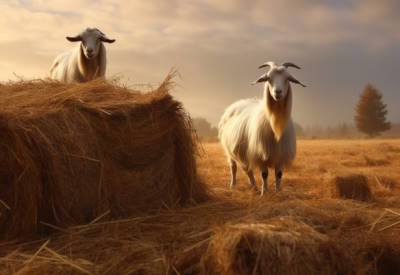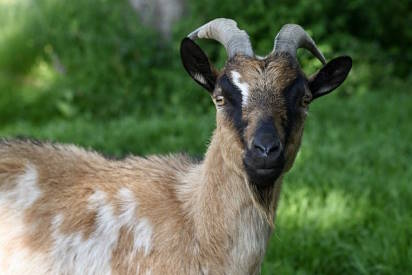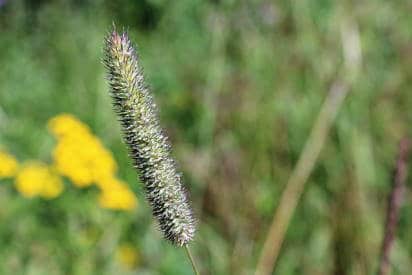Growing up on a farm, I’ve had my fair share of “can goats eat alfalfa?” debates over the breakfast table. The answer? Absolutely, goats can eat alfalfa, and many consider it a superfood in the ruminant world. However, like any dietary choice, the devil is in the details.
Having witnessed the positive transformation in our goats’ health and vitality when we introduced them to alfalfa, I also learned that it wasn’t a simple all-you-can-eat affair. It’s crucial to strike a balance to avoid potential pitfalls.
Drawing from personal experiences and observations, this article dives deep into the world of alfalfa, its benefits for goats, and the best practices to adopt for a happy, healthy herd.
Understanding Alfalfa Basics
Alfalfa, with its vibrant green hue, stands out in the pasture world. It’s revered by many, but do we know why?
What is alfalfa?
Descendant of the wild Medicago species, alfalfa is a perennial flowering plant. The depth of its roots, sometimes extending over 15 feet into the ground, is impressive. This means it’s not only drought-tolerant but also adept at nutrient absorption.
How is it grown and harvested?
Picture vast, sun-kissed fields filled with the green expanse of alfalfa swaying gently. Farmers grow it in rotations, enhancing soil health. Once it blooms, it’s mown, dried into hay in the sun, and then baled, ready for hungry animals.
Nutritional content of alfalfa
Beyond its undeniable aesthetic appeal, alfalfa is a nutrition powerhouse. Think of it as a superfood salad: rich in calcium, vitamins (especially A, D, E, and K), and essential amino acids.
[GoatAffiliate]
The Benefits of Alfalfa for Goats
Imagine treating your goats to a five-star meal. That’s alfalfa for them.
Nutrient-rich profile
Each bite of alfalfa provides goats with a concoction of vitamins and minerals. This aids everything from bone strength to vision and even coat shine.
Improving digestion
For goats, digestion is an art. The fiber-rich alfalfa ensures a healthy rumination process. Their four-chambered stomach breaks it down, extracts nutrients, and keeps them energized.
Enhancing milk production in dairy goats
Want richer, creamier goat milk? Introducing alfalfa to a lactating goat’s diet can often do the trick. It not only increases milk volume but can also improve its nutritional profile.
Potential Concerns with Feeding Alfalfa to Goats
Every rose has its thorn, and for all its merits, alfalfa does come with caution tags.
Possibility of bloating
Picture a goat’s rumen as a fermentation vat. Too much alfalfa, especially introduced suddenly, can lead to excessive gas. It’s like giving them a beans feast. Always be watchful for bloating signs.
Weight management
While we all love well-rounded goats, overfeeding alfalfa can lead to obesity. And with that comes joint issues, decreased mobility, and other health challenges.
Calcium-to-phosphorus ratio
Science time! A goat’s diet needs a balanced calcium-to-phosphorus ratio, ideally around 2:1. Alfalfa is calcium-rich, and without balancing it out, we risk urinary calculi in goats, especially males.
Best Practices for Introducing Alfalfa to a Goat’s Diet
Eager to see your goats munch on alfalfa? Let’s make the transition seamless.
Start slow and monitor
It’s akin to introducing a new cuisine to your diet. Begin with sprinkling alfalfa, observe for any discomfort, and increase gradually.
Mixing with other forages
Diversity is not just a societal buzzword; it’s a dietary essential. By offering a mix of hays, you ensure your goats get a 360° nutrition profile.
Recognizing the difference between alfalfa hay and fresh alfalfa
Just like dried herbs vs. fresh ones in your kitchen, dried alfalfa hay and fresh alfalfa have nuanced differences in flavor and moisture content. Goats might need more water with fresh alfalfa.
Alternative Forages and Their Comparison to Alfalfa
Alfalfa is in the limelight, but let’s not forget the supporting actors.
Commonly fed forages to goats
There’s the refreshing Bermuda, the ever-popular Timothy, and the grainy goodness of oat and barley hays. Each has its unique selling point, from nutrient profiles to taste.
Nutritional differences
While alfalfa is the protein king, Timothy is more about fiber. Oat hay, on the other hand, can be a middle ground. And Bermuda? It’s often loved for its palatability.
Cost-effectiveness
Wallet considerations are real. Depending on where you are, alfalfa might be like buying gourmet food every day. Alternatives might offer a more balanced budget approach.
Alfalfa Pellets vs. Fresh Alfalfa Hay
The world of alfalfa offers various formats that can be served up to our goats. Two of the most common forms are alfalfa pellets and fresh alfalfa hay. While both originate from the same plant, the manner in which they’re processed and presented has some key distinctions. Let’s take a closer look.
Alfalfa Pellets
Compact nuggets of nutrition, alfalfa pellets are processed forms of the alfalfa plant. They undergo a transformation where the hay is ground and then compressed into small, digestible pellets.
Benefits:
- Convenience: No fluff or mess. They are easy to measure, store, and distribute.
- Consistent Nutrition: Each pellet has a uniform nutritional profile, ensuring consistency in every bite.
- Reduced Waste: Goats can sometimes be picky, leaving behind stems from fresh hay. With pellets, what you serve is what they consume.
Drawbacks
- Lacks Long Fibers: The natural long fibers, crucial for a goat’s rumination and digestion, are missing in the pellet form.
- Hydration: Pellets can be drier, so ensure your goats have ample water when feeding them pellets.
Fresh Alfalfa Hay
The sun-dried or naturally dried version of the alfalfa plant, fresh alfalfa hay retains the original structure of the plant, including leaves, stems, and flowers.
Benefits:
- Natural Form: Allows goats to engage in their inherent grazing and chewing behaviors.
- Digestive Health: The long fibers are great for a goat’s digestion, aiding the rumination process.
- Taste and Texture: Many goats relish the varied textures, enjoying both the crunchy stems and soft leaves.
Drawbacks:
- Storage: Fresh alfalfa hay requires more space and care in storage to prevent mold growth.
- Potential for Waste: Goats might sift through, picking their favorite parts and leaving behind the less desirable stems.
Choosing between alfalfa pellets and fresh alfalfa hay depends on your goals, storage capabilities, and your goats’ preferences. While pellets offer convenience and consistency, fresh hay provides a more natural feeding experience. As with many things in life, balance is key; a combination of both might be the ticket to happy, healthy goats.
Storing Alfalfa for Goats
Ensuring that your goats get the best from their alfalfa requires not just a keen understanding of their dietary needs, but also meticulous care in storing the alfalfa. Whether it’s fresh alfalfa hay or alfalfa pellets, proper storage is pivotal in retaining its nutritional value and preventing any deterioration or contamination.
Fresh Alfalfa Hay
Fresh alfalfa hay, in its dried form, is bulkier and requires a bit more attention during storage.
Tips
- Dry and Cool Spaces: Store alfalfa hay in a location where it remains dry. Moisture is the enemy here, as it can lead to mold growth, which is harmful to goats.
- Away from Direct Sunlight: While the sun is used to dry fresh alfalfa initially, extended exposure post-drying can degrade its nutrients.
- Elevate from the Ground: Use pallets or racks to keep hay bales off the ground. This prevents moisture from creeping up and causing spoilage.
- Adequate Ventilation: Ensure there’s good airflow to prevent humidity build-up, which can facilitate mold growth.
Alfalfa Pellets
Alfalfa pellets, being compact and processed, are less prone to spoilage than fresh hay but still require care.
Tips:
- Sealed Containers: Store the pellets in airtight containers or bags to prevent moisture penetration.
- Cool and Dark Location: Like their hay counterpart, pellets should be stored away from direct sunlight to maintain their nutrient quality.
- Pest-Free: Ensure the storage space is free from pests like rodents, which can contaminate the pellets.
Remember, the quality of alfalfa your goats consume directly reflects the care taken in its storage. When stored right, alfalfa remains a potent nutritional source, helping your goats thrive. While these guidelines offer a general directive, always keep an eye out for any signs of spoilage and regularly check stored alfalfa for optimal quality.
What Other Animal Feeds Can Goats Eat Apart from Alfalfa?
Every farmer or goat owner knows that diversity in diet can be both a blessing and a challenge. While alfalfa reigns supreme in many feed discussions, the vast world of potential goat feeds is broad and varied. Let’s journey through some of these options and understand their impact on our hoofed friends.
Timothy Hay
A popular choice among many livestock owners, Timothy hay is a cool-season perennial grass with a high fiber content. It’s especially useful for adult goats that don’t require the higher protein content present in alfalfa. In essence, Timothy hay can be a fantastic supplement or alternative, aiding digestion and supporting overall health.
Read More: Can Goats Eat Timothy Hay? Unveiling The Full Story
Straw
Straw is more of a bedding material than a primary feed. While goats might nibble on straw, it’s nutritionally inferior compared to other hays. It provides bulk and roughage but lacks the essential nutrients required for a balanced diet. Use straw as a supplement or bedding, but don’t rely on it as a primary food source.
Read More: Can Goats Eat Straw? Debunking Myths & Exploring Facts
Sweet Feed
Sweet feed, as the name suggests, is a mix of grains and molasses, making it palatable (and, dare we say, a treat?) for goats. While it can provide energy, it’s akin to junk food if given in excess. It’s essential to moderate the intake as overconsumption can lead to obesity and other health issues. Think of it as a dessert, not the main course!
Read More: Can Goats Eat Sweet Feed? 5 Excellent Benefits
Beet Pulp
Beet pulp, a byproduct from the sugar beet industry, is a digestible fiber source that many goats seem to relish. It acts as a filler and an energy source, making it particularly beneficial during winter months or for lactating goats. When soaked, it becomes a mushy treat that can help hydrate and provide roughage. Always introduce it gradually and ensure it’s free from any additives.
Read More: Can Goats Eat Beet Pulp? 7 Excellent Benefits
Bermuda Hay
Bermuda hay is a fine-stemmed option with a texture that many goats find agreeable. It’s a warm-season grass that provides decent protein and fiber content. While not as protein-rich as alfalfa, it can be a foundational forage for goats, especially when mixed with other hays to ensure a rounded diet.
Read More: Can Goats Eat Bermuda Hay? A Delicious Dive into Dietary Choices
Can goats eat alfalfa – final thoughts
In the grand buffet of goat diets, alfalfa surely takes the centerpiece. It’s like the kale smoothie of the ruminant world, packed with nutrients and bound to give that extra pep in their step. From its impressive nutritional profile to its influence on milk production, the benefits are undeniable. Yet, like any superhero, alfalfa has its kryptonite. Introduce it thoughtfully, balance it well, and keep an eye out for potential challenges.
As the sun sets over the farm, I often find myself reflecting on these alfalfa adventures. It’s been quite the journey – filled with bales of learning, a few bloated bellies, and many satisfied bleats. So, can goats eat alfalfa? Certainly! But always with knowledge, care, and a sprinkling of love.
Related Articles:







